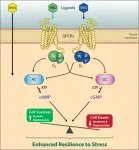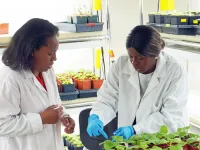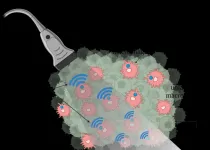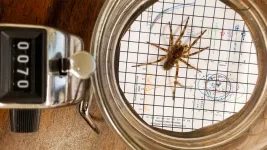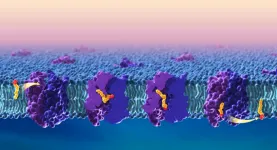Plastic can drift far away from its starting point as it sinks into the sea
2023-05-08
(Press-News.org) Discarded or drifting in the ocean, plastic debris can accumulate on the water’s surface, forming floating islands of garbage. Although it’s harder to spot, researchers suspect a significant amount also sinks. In a new study in ACS’ Environmental Science & Technology, one team used computer modeling to study how far bits of lightweight plastic travel when falling into the Mediterranean Sea. Their results suggest these particles can drift farther underwater than previously thought.
From old shopping bags to water bottles, plastic pollution is besieging the oceans. Not only is this debris unsightly, animals can become trapped in it or mistakenly eat it. And if it remains in the water, plastic waste can release organic pollutants. The problem is most visible on the surface, where currents can aggregate this debris into massive, so-called garbage patches. However, plastic waste also collects much deeper. Even material that weighs less than water can sink as algae and other organisms glom onto it, and through other processes. Bits of this light plastic, which typically measure 5 millimeters or less, have turned up at least half a mile below the surface. Researchers don’t know much about what happens when plastic sinks, but they generally assume it falls straight down from the surface. However, Alberto Baudena and his colleagues suspected this light plastic might not follow such a direct route.
To test this assumption, they used an advanced computer model developed to track plastic at sea and incorporated extensive data already collected on floating plastic pollution in the Mediterranean Sea. They then simulated nearly 7.7 million bits of plastic distributed across the sea and tracked their virtual paths to depths as great as about half a mile. Their results suggested that the slower the pieces sank, the farther currents carried them from their points of origin, with slowest traveling an average of roughly 175 miles laterally. While observations of the distribution of plastic underwater are limited, the team found their simulations agree with those available in the Mediterranean. Their simulations also suggested that currents may push plastic toward coastal areas and that only about 20% of pollution near coasts originates from the nearest country. These particles’ long journeys mean this plastic has greater potential to interact with, and harm, marine life, according to the researchers.
The authors acknowledge funding from the International Union for Conservation of Nature, the Tara Expeditions Foundation and the Albert II Monaco Foundation.
The American Chemical Society (ACS) is a nonprofit organization chartered by the U.S. Congress. ACS’ mission is to advance the broader chemistry enterprise and its practitioners for the benefit of Earth and all its people. The Society is a global leader in promoting excellence in science education and providing access to chemistry-related information and research through its multiple research solutions, peer-reviewed journals, scientific conferences, eBooks and weekly news periodical Chemical & Engineering News. ACS journals are among the most cited, most trusted and most read within the scientific literature; however, ACS itself does not conduct chemical research. As a leader in scientific information solutions, its CAS division partners with global innovators to accelerate breakthroughs by curating, connecting and analyzing the world’s scientific knowledge. ACS’ main offices are in Washington, D.C., and Columbus, Ohio.
To automatically receive news releases from the American Chemical Society, contact newsroom@acs.org.
Follow us: Twitter | Facebook | LinkedIn | Instagram
END
ELSE PRESS RELEASES FROM THIS DATE:
2023-05-08
A team of Florida State University researchers has further developed a new generation of organic-inorganic hybrid materials that can improve image quality in X-ray machines, CT scans and other radiation detection and imaging technologies.
Professor Biwu Ma from the Department of Chemistry and Biochemistry and his colleagues have developed a new class of materials that can act as highly efficient scintillators, which emit light after being exposed to other forms of high energy radiations, such as X-rays.
The team’s most recent study, published in Advanced Materials, is an improvement upon their previous research to develop better scintillators. The new design concept produces ...
2023-05-08
Astronomers used NASA’s James Webb Space Telescope to image the warm dust around a nearby young star, Fomalhaut, in order to study the first asteroid belt ever seen outside of our solar system in infrared light. But to their surprise, the dusty structures are much more complex than the asteroid and Kuiper dust belts of our solar system. Overall, there are three nested belts extending out to 14 billion miles (23 billion kilometers) from the star; that’s 150 times the distance of Earth from the Sun. The scale of the outermost belt is roughly twice the scale of our ...
2023-05-08
Irvine, CA – May xx, 2023 – In a University of California, Irvine-led study, researchers have discovered small-molecule drugs with potential clinical utility in the treatment of age-related macular degeneration (AMD), diabetic retinopathy (DR), and retinitis pigmentosa (RP).
The study, titled, “Stress resilience-enhancing drugs preserve tissue structure and function in degenerating retina via phosphodiesterase inhibition,” was published in the Proceedings of the National Academy of Sciences.
“In this study, we introduce a new class of therapeutics called ‘Stress ...
2023-05-08
ST. LOUIS, MO - May 8, 2023 – Graduate student Amie Fornah Sankoh recently stood in front of 150 colleagues family and friends at the Donald Danforth Plant Science Center to defend her thesis, Investigating the Effects of Salicylic acid on Intercellular Trafficking via Plasmodesmata in Nicotiana benthamiana. Upon her successful defense, Dr. Amie Sankoh became the first Deaf, Black woman to receive a PhD in any STEM discipline.
Completing a PhD is a challenging undertaking for anyone; to do so without easy access to the kinds of verbal communication that hearing people ...
2023-05-08
CHICAGO, May 8, 2023 – Macrophages, a type of white blood cell, defend the body by engulfing and digesting foreign particles, such as bacteria, viruses, and dead cells. The immune cells also tend to accumulate in solid tumors, so tracking them could enable new ways to detect cancer and the earliest stages of metastasis.
As part of the 184th Meeting of the Acoustical Society of America, Ashley Alva of the Georgia Institute of Technology will describe how attaching microbubbles to macrophages can create high-resolution and sensitive tracking images useful for disease diagnosis. Her presentation, “Tracking macrophages ...
2023-05-08
CHICAGO, May 8, 2023 – Imagine a cocktail party full of 3D-printed, humanoid robots listening and talking to each other. That seemingly sci-fi scene is the goal of the Augmented Listening Laboratory at the University of Illinois Urbana-Champaign. Realistic talking (and listening) heads are crucial for investigating how humans receive sound and developing audio technology.
The team will describe the talking human head simulators in their presentation, “3D-printed acoustic head simulators that talk and move,” on Monday, May 8, at 12:15 p.m. Eastern U.S. in the Northwestern/Ohio State room of the Chicago Marriott Downtown Magnificent Mile Hotel. The talk comes as part of ...
2023-05-08
The World Mitochondria Society is organizing its 14th world conference, Targeting Mitochondria 2023, on October 11-13 at the Steigenberger Hotel Am Kanzleramt, Berlin. Targeting Mitochondria 2023 will address the latest advances and perspectives in mitochondrial research and provide an outlook on future mitochondrial therapies.
Volkmar Weissig, president of the World Mitochondria Society, and Marvin Edeas, president of the scientific committee, said, "This year we will have specific sessions on innovations such as mitochondria in space, exosome-based mitochondrial ...
2023-05-08
A limited menu of prey may weave a tangled food web by emboldening wolf spiders of multiple species to dine on each other and even cannibalize their own, says a study from the University of Nebraska–Lincoln.
Ecologists have long known that predators with otherwise-similar diets can coexist by effectively divvying up the food sources of a community to ease competition and, ideally, leave enough prey for everyone. But analyses of wolf spider species in Nebraska suggest that when the diversity of their mutual prey is lacking, the eight-legged ...
2023-05-08
Researchers at the UCLA David Geffen School of Medicine, the Howard Hughes Medical Institute at UCLA and the National Institutes of Health have developed a zebrafish model that provides new insight into how the brain acquires essential omega-3 fatty acids, including docosahexaenoic acid (DHA) and linolenic acid (ALA). Their findings, published in Nature Communications, have the potential to improve understanding of lipid transport across the blood-brain barrier and of disruptions in this process that can lead to birth defects or neurological conditions. The model may also enable researchers to design drug molecules that are capable of directly ...
2023-05-08
When you need a bit of motivation, it often has to come from within. New research suggests cancer-fighting immune cells have found a way to do just that.
Scientists at University of California San Diego have discovered a property of T cells that could inspire new anti-tumor therapeutics. Through a previously undescribed form of cell auto-signaling, T cells were shown to activate themselves in peripheral tissues, fueling their ability to attack tumors.
The study, published May 8, 2023 in Immunity, was led by study first author and postdoctoral fellow Yunlong Zhao, PhD, and co-senior authors Enfu Hui, PhD, professor in the School of Biological Sciences at UC ...
LAST 30 PRESS RELEASES:
[Press-News.org] Plastic can drift far away from its starting point as it sinks into the sea


